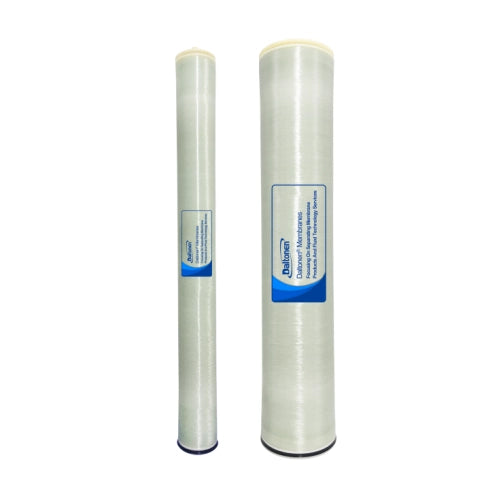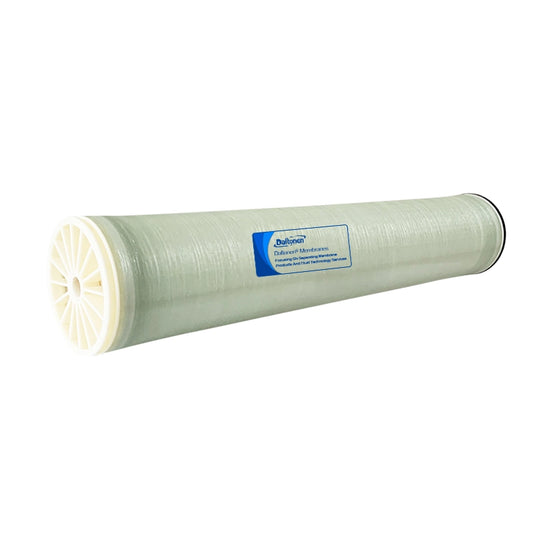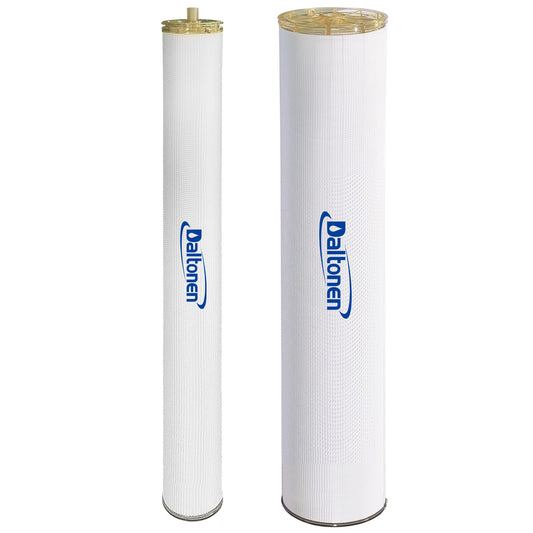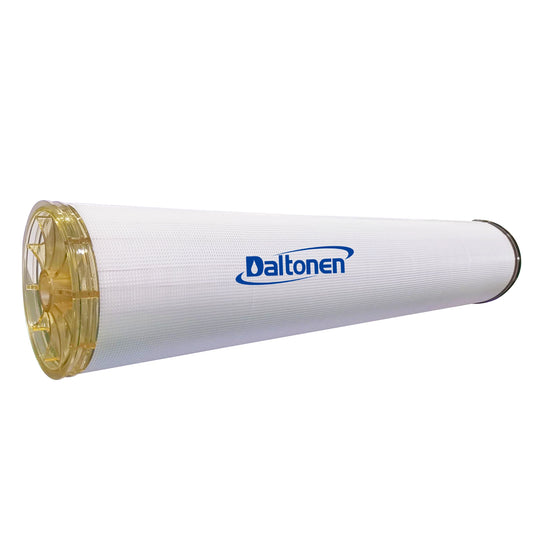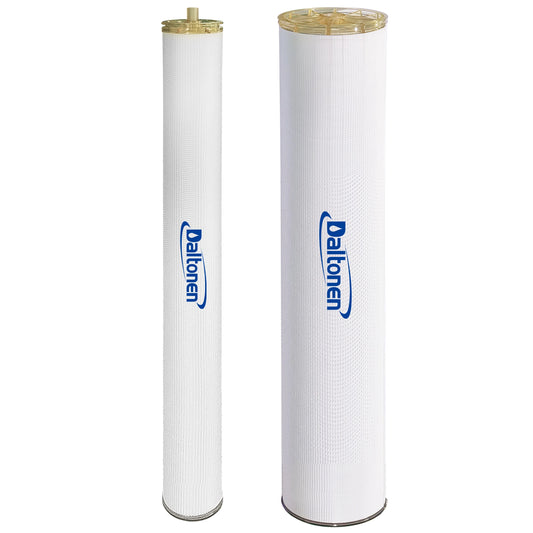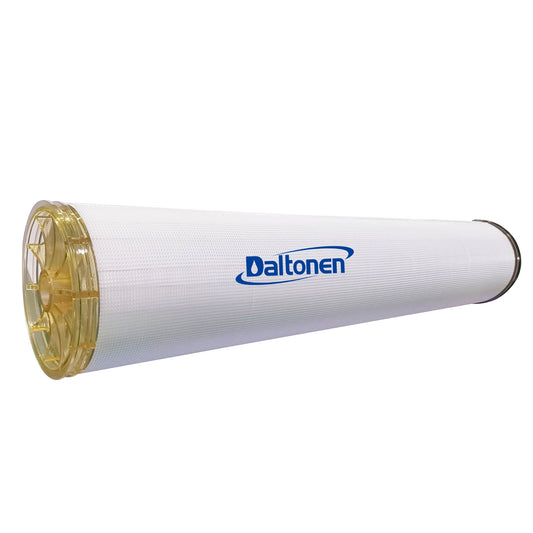How to Choose RO Reverse Osmosis Membranes for High-Salinity Groundwater
16 Apr 2025
Analysis of the Characteristics of High-Salinity Groundwater
1.1 Salt Composition and Concentration Range
The salt composition of high-salinity groundwater is complex, mainly including common salts such as sodium chloride, sodium sulfate, and sodium carbonate. The salt composition varies in different regions due to differences in geological conditions and hydrological environments. For example, in some coastal areas, the content of sodium chloride in high-salinity groundwater may account for more than 60% of the total salinity, while in some inland saline-alkali lands, the content of sodium sulfate and sodium carbonate is relatively high, and the proportion of sodium chloride may be around 40%. The salinity concentration range of high-salinity groundwater is wide, usually between 10,000mg/L and 300,000mg/L, and in some areas it is even higher. For example, the salinity concentration of high-salinity groundwater in a saline-alkali land in Northwest China can reach 250,000mg/L, while the salinity concentration of high-salinity groundwater in a coastal area in the east is about 120,000mg/L. Accurate knowledge of the salt composition and concentration range of high-salinity groundwater is crucial for selecting suitable RO reverse osmosis membranes, as different membrane materials and structures have different retention performance and tolerance for different salts.

1.2 Other Impurities Content
In addition to high concentrations of salts, high-salinity groundwater also contains a variety of other impurities, which have an important impact on the selection and operation of RO reverse osmosis membranes. Among them, suspended solid particles are one of the common impurities, with a content usually ranging from 10mg/L to 100mg/L. These particles may block membrane pores, resulting in a decrease in membrane flux and a shortened membrane life. For example, in some polluted high-salinity groundwater, the content of suspended solid particles may be as high as 80mg/L, which will seriously affect the performance of RO reverse osmosis membranes if no pre-treatment is carried out. In addition, high-salinity groundwater may also contain a certain amount of organic matter, such as humic acid and fulvic acid, with a content generally ranging from 5mg/L to 50mg/L. These organic substances will adsorb on the membrane surface and form an organic pollution layer, increasing the operating resistance of the membrane. For example, in some high-salinity groundwater rich in organic matter, the content of organic matter can reach 30mg/L, which has a significant impact on the performance of the membrane. At the same time, high-salinity groundwater may also contain microorganisms such as bacteria and algae, with a quantity ranging from 10^3 to 10^6 per milliliter. Microorganisms will reproduce on the membrane surface to form a biofilm, further aggravating the pollution and blockage problems of the membrane. Understanding the content of these impurities in high-salinity groundwater helps to consider corresponding pre-treatment measures and the anti-pollution performance of the membrane when selecting RO reverse osmosis membranes, so as to ensure the stable operation of the system.
Overview of RO Reverse Osmosis Membrane Types
2.1 Conventional Reverse Osmosis Membranes
Conventional reverse osmosis membranes are the most widely used membrane type, with certain retention performance and desalination rate.
-
Material and Structure: Conventional reverse osmosis membranes are mainly made of materials such as polyamide, and their structure is an asymmetric membrane, with a dense skin layer and a support layer. This structure enables the membrane to maintain a relatively high desalination rate while having certain mechanical strength and stability.
-
Performance Features: The desalination rate is usually between 95% and 99%, which can effectively remove most of the salts in water. For example, when treating high-salinity groundwater with a salinity concentration of 10,000mg/L, conventional reverse osmosis membranes can reduce the salinity concentration to around 100mg/L. However, conventional reverse osmosis membranes have certain limitations when dealing with high-salinity groundwater with high salinity concentration and complex impurities. The operating pressure is generally between 1.5MPa and 3.0MPa, and when the salinity concentration is too high, a higher pressure is required to maintain the normal desalination effect, which will increase energy consumption and operating costs.
-
Application Scenarios: Suitable for the treatment of high-salinity groundwater with lower salinity concentration (such as 10,000mg/L to 50,000mg/L) and less impurities. In these scenarios, conventional reverse osmosis membranes can achieve good desalination effects at a lower cost.
2.2 High-Pressure Reverse Osmosis Membranes
High-pressure reverse osmosis membranes are a special type of membrane developed to meet the water treatment needs of high-salinity water.
-
Material and Structure: High-pressure reverse osmosis membranes are also based on materials such as polyamide, but through special preparation processes and material modifications, they can operate stably under higher pressures. Their structure is more dense and can withstand higher pressures without deformation or damage.
-
Performance Features: The desalination rate can reach more than 99%, and even in high-salinity groundwater with a salinity concentration as high as 200,000mg/L, it can reduce the salinity concentration to below 200mg/L. The operating pressure of high-pressure reverse osmosis membranes is usually between 5.0MPa and 10.0MPa. Although higher pressure will lead to higher energy consumption, it can effectively treat high-salinity groundwater and meet the desalination needs in some special scenarios.
-
Application Scenarios: Suitable for the treatment of high-salinity groundwater with extremely high salinity concentration (such as 100,000mg/L to 300,000mg/L), especially in industrial water use and seawater desalination fields where strict control of the salinity concentration of the effluent is required. For example, in some coastal seawater desalination projects, high-pressure reverse osmosis membranes are widely used to ensure that the desalinated seawater meets the standards for drinking water or industrial water.
2.3 Anti-Pollution Reverse Osmosis Membranes
Anti-pollution reverse osmosis membranes are designed to deal with the complex impurity components in high-salinity groundwater, aiming to improve the anti-pollution ability and operational stability of the membrane.
-
Material and Structure: Anti-pollution reverse osmosis membranes usually use modified polyamide materials, and improve the surface properties of the membrane by introducing hydrophilic groups on the membrane surface or adding nanomaterials, reducing the adsorption and deposition of impurities on the membrane surface. The structural design also focuses more on anti-pollution performance, for example, using porous support layers and more uniform skin layer structures to reduce the blockage of membrane pores by impurities.
-
Performance Features: Anti-pollution reverse osmosis membranes show significant anti-pollution ability when treating high-salinity groundwater containing a large amount of suspended solid particles, organic matter, and microorganisms. The membrane flux decline rate is more than 50% slower than that of conventional reverse osmosis membranes, and the service life can be extended by 30% to 50%. For example, when treating high-salinity groundwater with a suspended solid particle content as high as 80mg/L and an organic matter content of 30mg/L, anti-pollution reverse osmosis membranes can maintain stable operating performance for a longer period of time, while conventional reverse osmosis membranes may experience serious blockage problems in a short time. The desalination rate is generally between 95% and 98%, although slightly lower than that of high-pressure reverse osmosis membranes, but under the guarantee of anti-pollution performance, it can better adapt to complex water quality conditions.
-
Application Scenarios: Suitable for the treatment of high-salinity groundwater with higher impurity content (such as suspended solid particle content exceeding 50mg/L, organic matter content exceeding 20mg/L, or microbial quantity exceeding 10^5 per milliliter). In these scenarios, anti-pollution reverse osmosis membranes can effectively reduce the burden of pre-treatment, reduce the cleaning frequency and replacement cost of the membrane, and improve the overall operating efficiency and economy of the system.
Key Factors in Membrane Selection
3.1 Desalination Rate Requirements
When selecting RO reverse osmosis membranes, the desalination rate is one of the key indicators. Different application scenarios have different requirements for the desalination rate. For example, for drinking water production, the desalination rate needs to reach more than 99% to ensure that the water quality meets the standards. In the industrial water field, such as electronic chip manufacturing, the water quality purity requirement is extremely high, and the desalination rate needs to be close to 100%. In some primary industrial water use scenarios, such as ordinary cooling water systems, a desalination rate of around 95% can meet the needs. According to the salinity concentration range of high-salinity groundwater, when the salinity concentration is between 10,000mg/L and 50,000mg/L, conventional reverse osmosis membranes can meet the general desalination needs; for high-salinity groundwater with a salinity concentration of 100,000mg/L to 300,000mg/L, high-pressure reverse osmosis membranes are a more suitable choice, with a desalination rate that can be stably maintained at more than 99%, effectively reducing the effluent salinity concentration to below 200mg/L, and meeting the requirements of scenarios with strict water quality requirements.
3.2 Matching of Water Production and System Scale
The water production of RO reverse osmosis membranes must be matched with the system scale to ensure the efficient operation of the system. Water production is affected by factors such as membrane area, operating pressure, and feed water quality. When treating high-salinity groundwater, the larger the membrane area, the higher the water production usually is. For example, for a small industrial water system with a daily water demand of 100 cubic meters, a reverse osmosis membrane component with a smaller membrane area can be selected; while for a large-scale seawater desalination plant with a daily water demand of tens of thousands of cubic meters, a large-scale membrane component array is required. Operating pressure also affects water production. Although high-pressure reverse osmosis membranes can treat high-salinity water, high operating pressure will increase energy consumption. Therefore, when selecting membranes, it is necessary to comprehensively consider factors such as system scale and energy consumption costs. For scenarios with high salinity concentration and large-scale treatment needs, such as large-scale coastal seawater desalination projects, high-pressure reverse osmosis membranes, although with high energy consumption, can meet the large-scale water production needs; while in some small and medium-sized high-salinity groundwater treatment scenarios, conventional reverse osmosis membranes or anti-pollution reverse osmosis membranes can be prioritized, and the membrane area and operating conditions can be optimized to ensure water production while reducing energy consumption.
Impact of Pre-treatment on Membrane Selection
4.1 Removal of Suspended Solids and Colloids
The suspended solid particles and colloidal substances in high-salinity groundwater are important factors affecting the performance of RO reverse osmosis membranes. These impurities can block membrane pores, reduce membrane flux, and shorten the service life of the membrane. During pre-treatment, methods such as coagulation and sedimentation, and sand filtration can be used to remove suspended solids and colloids, which can significantly improve the operating conditions of the membrane.
-
Coagulation and Sedimentation: Coagulants such as aluminum sulfate and polyaluminum chloride are added to high-salinity groundwater, causing the suspended solids and colloidal particles in the water to aggregate into larger particles, which are easier to precipitate and remove. Research shows that coagulation and sedimentation can remove 80% to 90% of suspended solid particles and 60% to 70% of colloidal substances. For example, in a high-salinity groundwater treatment project, after coagulation and sedimentation, the content of suspended solid particles was reduced from 80mg/L to about 10mg/L, effectively reducing the risk of membrane pore blockage.
-
Sand Filtration: The water after coagulation and sedimentation passes through a sand filter layer to further remove residual suspended solids and colloids. Sand filtration can remove particles larger than 5 microns, making the effluent water quality more stable. The content of suspended solid particles in high-salinity groundwater after sand filtration can be reduced to below 5mg/L, providing good water quality conditions for the stable operation of RO reverse osmosis membranes. When selecting RO reverse osmosis membranes, if pre-treatment can effectively remove suspended solids and colloids, the requirements for the membrane's anti-pollution performance can be appropriately reduced, and conventional reverse osmosis membranes or high-pressure reverse osmosis membranes can be selected to meet desalination needs.

4.2 Adjustment of Water Chemical Properties
The chemical properties of high-salinity groundwater are complex, and the dissolved solids, hardness components, pH value, etc. in it will have an impact on RO reverse osmosis membranes. By adjusting the chemical properties of water through pre-treatment, the operating environment of the membrane can be optimized and the service life of the membrane can be extended.
-
Softening Treatment: High-salinity groundwater contains a large amount of calcium, magnesium and other hardness components, which will form scale on the membrane surface, reducing the desalination rate and flux of the membrane. Softening treatment using ion exchange resins can remove calcium and magnesium ions from water and reduce water hardness. For example, the hardness of a certain high-salinity groundwater is 500mg/L (calculated as CaCO₃), and after softening treatment with ion exchange resins, the hardness can be reduced to below 50mg/L. The risk of scaling on the membrane after softening treatment is greatly reduced, and conventional reverse osmosis membranes or anti-pollution reverse osmosis membranes can be selected to meet different desalination needs and water quality conditions.
-
pH Adjustment: The pH value of high-salinity groundwater may be acidic or alkaline, and different RO reverse osmosis membranes have different tolerance ranges for pH values. For example, the tolerance pH range of polyamide reverse osmosis membranes is generally 2 to 11, but when operating within the optimal pH range (6 to 8), the performance of the membrane is more stable. By adding acid or alkali to the water to adjust the pH value, the pH value of the water can be brought to the optimal operating range of the membrane. For example, the pH value of a certain high-salinity groundwater is 9.5, and after adjusting to 7.5 with an appropriate amount of hydrochloric acid, the desalination rate of the reverse osmosis membrane is increased by 5%, and the membrane flux is also more stable. When selecting membranes, the appropriate membrane materials and structures should be selected according to the pH range of the water after pre-treatment to ensure the long-term stable operation of the membrane.
Cost Considerations
5.1 Initial Investment Cost
When selecting RO reverse osmosis membranes, the initial investment cost is one of the important factors to consider. There are significant differences in price between different types and specifications of reverse osmosis membranes.
-
Membrane Component Cost: The price of conventional reverse osmosis membrane components is relatively low, with a price of about 100 to 200 yuan per square meter of membrane area. High-pressure reverse osmosis membranes, due to their special preparation processes and material modifications, are more expensive, with a price of 300 to 500 yuan per square meter of membrane area. Anti-pollution reverse osmosis membranes, which use modified materials and special surface treatment technologies, are also relatively expensive, with a price of about 250 to 400 yuan per square meter of membrane area. For example, for a medium-sized high-salinity groundwater treatment system that requires the installation of 100 square meters of membrane components, the initial investment cost of conventional reverse osmosis membranes is about 10,000 to 20,000 yuan, while the initial investment cost of high-pressure reverse osmosis membranes may reach 30,000 to 50,000 yuan.
-
Pre-treatment System Cost: The investment cost of the pre-treatment system also affects the total initial investment of the entire system. If the high-salinity groundwater contains a large amount of impurities and requires complex pre-treatment processes, such as multi-stage filtration, softening treatment, and pH adjustment, the investment cost of the pre-treatment system will increase significantly. For example, a complete pre-treatment system, including coagulation and sedimentation tanks, sand filter vessels, ion exchange resin softening devices, and pH adjustment equipment, may have an investment cost of 50,000 to 100,000 yuan. Therefore, when selecting RO reverse osmosis membranes, it is necessary to comprehensively consider the cost of membrane components and pre-treatment systems to determine the total initial investment of the system.
5.2 Operation and Maintenance Costs
Operation and maintenance costs are factors that need to be focused on in the long-term operation of RO reverse osmosis membrane systems, as they directly affect the economy and sustainability of the system.
-
Energy Consumption Costs: Energy consumption is the main part of operation and maintenance costs. Conventional reverse osmosis membranes have lower operating pressure and relatively lower energy consumption. For example, when treating high-salinity groundwater with a salinity concentration of 10,000mg/L, the energy consumption of conventional reverse osmosis membranes is about 2kWh/m³. High-pressure reverse osmosis membranes have significantly higher energy consumption due to higher operating pressure. When treating high-salinity groundwater with a salinity concentration of 200,000mg/L, the energy consumption of high-pressure reverse osmosis membranes may reach 5kWh/m³. The operating pressure of anti-pollution reverse osmosis membranes is similar to that of conventional reverse osmosis membranes, but their anti-pollution performance can reduce the frequency of membrane cleaning, thereby indirectly reducing energy consumption. For example, when treating high-salinity groundwater containing a large amount of impurities, the cleaning cycle of anti-pollution reverse osmosis membranes can be extended by 30% to 50%, reducing the system downtime and energy consumption caused by cleaning.
-
Membrane Cleaning and Replacement Costs: The frequency of membrane cleaning and replacement directly affects operation and maintenance costs. Conventional reverse osmosis membranes, when treating high-salinity groundwater, are prone to pollution and have a shorter cleaning cycle, generally requiring cleaning every 3 to 6 months. The cost of each cleaning is about 1,000 to 2,000 yuan, including cleaning agent costs and labor costs. Anti-pollution reverse osmosis membranes, due to their surface modifications, can effectively reduce the adsorption and deposition of impurities, and the cleaning cycle can be extended to 6 to 12 months or even longer. Although high-pressure reverse osmosis membranes have a high desalination rate, due to the high operating pressure, the membrane wear is faster and the replacement frequency is relatively higher. For example, the service life of high-pressure reverse osmosis membranes is generally 3 to 5 years, while the service life of conventional reverse osmosis membranes and anti-pollution reverse osmosis membranes can reach 5 to 8 years. The cost of replacing membrane components is high. For example, for a 100 square meter membrane component, the cost of replacing high-pressure reverse osmosis membranes may reach 30,000 to 50,000 yuan, while the cost of replacing conventional reverse osmosis membranes is about 10,000 to 20,000 yuan.
-
Pre-treatment System Operating Costs: The operating costs of the pre-treatment system also affect the overall operation and maintenance costs of the system. The pre-treatment system requires regular replacement of filter media, resins and other consumables, as well as the consumption of chemical reagents. For example, the sand filtration system needs to replace the filter media every 6 to 12 months, with a cost of about 5,000 to 10,000 yuan; the ion exchange resin softening system needs to replace the resin every 1 to 2 years, with a cost of about 8,000 to 15,000 yuan. In addition, coagulation and sedimentation processes require the consumption of coagulants, with annual reagent costs of about 2,000 to 5,000 yuan. Therefore, when selecting RO reverse osmosis membranes, it is necessary to comprehensively consider the operating costs of the pre-treatment system to ensure the economy and sustainability of the entire system.
Case Analysis and Experience Learning
6.1 Successful Application Cases
In a coastal chemical park, the salinity concentration of high-salinity groundwater is as high as 200,000mg/L, mainly composed of sodium chloride, and contains a large amount of suspended solid particles (about 80mg/L) and organic matter (about 30mg/L). The park uses high-pressure reverse osmosis membranes for treatment, and the system operates stably, reducing the salinity concentration of the effluent to below 200mg/L, meeting the industrial water needs of the park. In the pre-treatment环节, through coagulation and sedimentation and sand filtration, more than 90% of the suspended solid particles are effectively removed, reducing the risk of membrane blockage; at the same time, regular membrane cleaning extends the service life of the membrane and reduces operating costs. This case shows that in scenarios with high salinity concentration and high impurity content, high-pressure reverse osmosis membranes combined with effective pre-treatment measures can achieve good treatment effects and economy.
In an inland saline-alkali land agricultural irrigation project, the salinity concentration of high-salinity groundwater is between 10,000mg/L and 50,000mg/L, mainly composed of sodium sulfate and sodium carbonate. The project uses anti-pollution reverse osmosis membranes for treatment. After pre-treatment to remove most of the suspended solids and colloids, the membrane system operates stably and the water quality of the effluent meets the requirements for agricultural irrigation. Anti-pollution reverse osmosis membranes show good anti-pollution ability during the treatment process. The membrane flux decline rate is more than 50% slower than that of conventional reverse osmosis membranes, and the service life is extended by 40%, reducing the frequency of membrane cleaning and replacement, and reducing operating and maintenance costs. This case shows that in scenarios with relatively low salinity concentration but high impurity content in high-salinity groundwater treatment, anti-pollution reverse osmosis membranes are a more suitable choice, which can effectively improve the operating efficiency and economy of the system.
6.2 Problems and Solutions
In practical applications, some high-salinity groundwater treatment projects have experienced membrane blockage problems. For example, in a project, the high-salinity groundwater contains a large number of microorganisms, with a quantity as high as 10^6 per milliliter. Microorganisms reproduce on the membrane surface to form a biofilm, resulting in a sharp decline in membrane flux. To solve this problem, the project team added ultraviolet sterilization equipment in the pre-treatment环节, effectively killing more than 99% of microorganisms, reducing the formation of biofilms, and regularly chemically cleaning the membrane to further reduce the risk of membrane blockage and ensure the stable operation of the system.
In some high-salinity groundwater treatment projects, there have been cases where the desalination rate did not meet the standards due to improper membrane selection. For example, in a project with a salinity concentration as high as 250,000mg/L, conventional reverse osmosis membranes were selected, resulting in the effluent salinity concentration not meeting the expected requirements. After re-evaluation and analysis, the project team replaced the membranes with high-pressure reverse osmosis membranes and optimized the operating parameters such as operating pressure. Finally, the salinity concentration of the effluent was reduced to below 200mg/L, meeting the water quality requirements. This case emphasizes that when selecting RO reverse osmosis membranes, it is necessary to reasonably select the membrane type according to the specific salinity concentration and water quality characteristics of high-salinity groundwater to ensure that the system achieves the expected desalination effect.
7. Summary
The selection of suitable RO reverse osmosis membranes in the treatment of high-salinity groundwater is a complex and crucial decision-making process. Through in-depth analysis of the characteristics of high-salinity groundwater, combined with the performance features of different types of RO reverse osmosis membranes, as well as considering key factors in membrane selection, the impact of pre-treatment, and cost considerations, scientific and rational guidance can be provided for practical applications.
The complex salt composition and wide concentration range of high-salinity groundwater, as well as the presence of various impurities, determine that a variety of factors need to be comprehensively considered when selecting RO reverse osmosis membranes. Conventional reverse osmosis membranes are suitable for scenarios with lower salinity concentration and less impurities; high-pressure reverse osmosis membranes are suitable for high-salinity treatment needs and can achieve high desalination rates; anti-pollution reverse osmosis membranes show good anti-pollution ability when facing complex impurities, which can effectively extend the service life of the membrane and reduce operating costs.
Desalination rate, matching of water production and system scale are key factors in membrane selection. Different application scenarios have different requirements for desalination rate, and it is necessary to select suitable membrane types according to specific needs. At the same time, the water production of the membrane must be matched with the system scale to ensure efficient operation. Pre-treatment has an important impact on membrane selection. By removing suspended solids and colloids through coagulation and sedimentation, sand filtration, and adjusting the chemical properties of water, the operating environment of the membrane can be optimized and the requirements for membrane performance can be reduced.
Cost considerations are also factors that cannot be ignored when selecting RO reverse osmosis membranes. The initial investment cost includes the cost of membrane components and pre-treatment systems. There are significant differences in price between different types and specifications of membranes, and the complexity of the pre-treatment system will affect the total cost. Operation and maintenance costs directly affect the economy and sustainability of the system, including energy consumption costs, membrane cleaning and replacement costs, and the operating costs of pre-treatment systems. By comprehensively analyzing these factors, the performance and cost of the system can be better balanced to achieve efficient and economical treatment of high-salinity groundwater.
The case analysis in practical applications further verifies the importance of rational selection of RO reverse osmosis membranes. Successful cases show that in scenarios with high salinity concentration and high impurity content, high-pressure reverse osmosis membranes combined with effective pre-treatment measures can achieve good treatment effects and economy; while in scenarios with relatively low salinity concentration but high impurity content, anti-pollution reverse osmosis membranes are a more suitable choice. At the same time, the discussion of problems and solutions also emphasizes that when selecting membranes, it is necessary to reasonably select the membrane type according to the specific characteristics of high-salinity groundwater, and optimize pre-treatment and operating parameters to ensure the stable operation of the system and achieve the expected desalination effect.
Tags:


